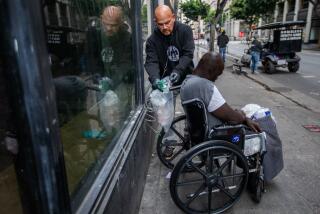Heart Attack Study Backs Use of Simpler Alternative to CPR
- Share via
Chest compressions that restore blood circulation are at least as effective as conventional CPR that includes mouth-to-mouth resuscitation in keeping heart attack victims alive until paramedics arrive, a new study has found.
The discovery has lifesaving implications because more than three-quarters of those who witness a heart attack are unwilling to administer CPR to a stranger because of hygienic concerns and fear of infection.
But mouth-to-mouth may not be necessary if professional help is on the way, according to researchers from the University of Washington.
Administering simple chest compressions to victims without attempting to help them breathe is sufficient to keep them alive until paramedics arrive on the scene, they report in today’s New England Journal of Medicine.
Instructions for chest compressions can be given much more quickly by 911 personnel than those for conventional CPR, the study reports. Moreover, it says, callers can understand them better and are more likely to use them, and victims are more likely to survive.
Simplifying the instructions provided to bystanders could save at least 750 lives per year in the United States, according to Washington statistician Alfred Hallstrom.
The new study “is of immense importance and will have worldwide implications,” according to Dr. Gordon A. Ewy of the University of Arizona Sarver Heart Center.
The conclusions apply only to heart attack victims. Drowning victims, people in respiratory arrest and victims of drug overdoses, among others, still require mouth-to-mouth resuscitation because their immediate problem is lack of oxygen, not lack of circulation.
Conventional CPR is better if there is someone present who knows how to perform it, the researchers note. But even people who have received CPR training tend to forget how to do it over time, and trying to reteach them over the telephone wastes valuable time during which the victim’s heart and other organs are not receiving oxygen.
It takes an average of 2.4 minutes to explain conventional CPR over the phone, Hallstrom said, but only 1 minute to explain chest compressions.
“The bottom line is, if you can do chest compression alone, it’s a whole lot better than doing nothing,” said Dr. Leonard Cobb, a co-author of the study.
New guidelines for 911 dispatchers reflecting the suggested changes will probably be adopted this summer, according to Robert Martin, executive director of the National Academy of Emergency Medical Dispatch. The academy develops guidelines that are used by most 911 centers in the United States.
“This is a good thing from the responder perspective,” Martin said. “We want to do something immediately that is going to be of the most value to the patient.”
The American Red Cross will probably also incorporate the findings into their guidelines for CPR, said Connie Harvey, a health and safety expert for the group. “We’re very excited about anything that will get more people involved in lifesaving activities,” she said.
Attempts to revive heart attack victims have a long history. In the last century, the patients would often be strapped onto a horse in hopes that the jolting would restore heart action. Later, patients were rolled over a barrel. Neither method was very successful.
Eventually, the so-called ABC system was developed: clear the Airway; restore Breathing with mouth-to-mouth; and restore Circulation with chest compressions.
“A trained rescuer is very likely going to increase the chances of survival by doing mouth-to-mouth along with chest compression,” Jerry Potts, director of science for the American Heart Assn.’s emergency cardiovascular care programs, said Wednesday. “However, we do recognize that some people are not able or willing to do mouth-to-mouth.”
Some groups and individuals have even recommended that everyone in the United States carry a mask that could be used to prevent contracting disease during mouth-to-mouth, but that approach has not been seriously considered.
The new technique is based on animal studies showing that chest compressions alone are effective in the first few minutes after a heart attack. The blood in the heart and arteries is still highly oxygenated, and simply moving it around the body nourishes vital tissues.
Hallstrom and his colleagues organized the seven-year study in Seattle, which has a very effective emergency response system. In the study, when dispatchers received a call that was identified as a heart attack, a computer told them whether to give complete CPR instructions or those for chest compressions alone: 241 patients received chest compressions alone and 279 received CPR.
To their surprise, the researchers found a higher success rate when compression alone was used. Overall, 10.4% of those receiving mouth-to-mouth survived and were eventually released from the hospital, compared with 14.6% of those receiving only chest compressions. That amounted to 20 additional lives saved over the course of seven years in the group that only received chest compressions.
Statistically, there were not enough patients in the study to prove that compression alone is the better approach, Hallstrom said, but “we are reasonably sure it’s better,” because victims are receiving more prompt treatment.
But Dr. Nicholas G. Bircher of the University of Pittsburgh cautioned that the results might be unique to Seattle, which has an average emergency response time of only 3.1 minutes.
Selection of patients is also important, Hallstrom noted. Apparent heart attacks in younger men and women are frequently the result of a drug overdose or other problem precipitated by respiratory arrest, and restoring breathing is crucial in such cases.
“But if you are over 55 and collapse, this [chest compressions] is probably the right thing for you,” he concluded.
(BEGIN TEXT OF INFOBOX / INFOGRAPHIC)
Chest Compressions for a Heart Attack Victim
People untrained in CPR can follow these instructions to help keep a heart attack victim alive until medical help arrives.
* Put the heel of your hand on the center of the chest between the nipples.
* Put your other hand on top of that hand.
* Push down firmly, on the heels of your hands only, one or two inches. Repeat, just as if you were pumping the chest.
* Keep pumping on the chest until professional help can take over.
Source: University of Washington






